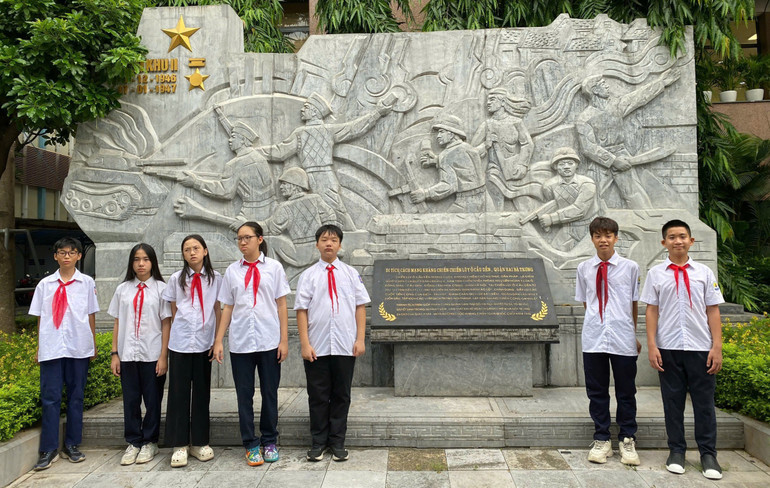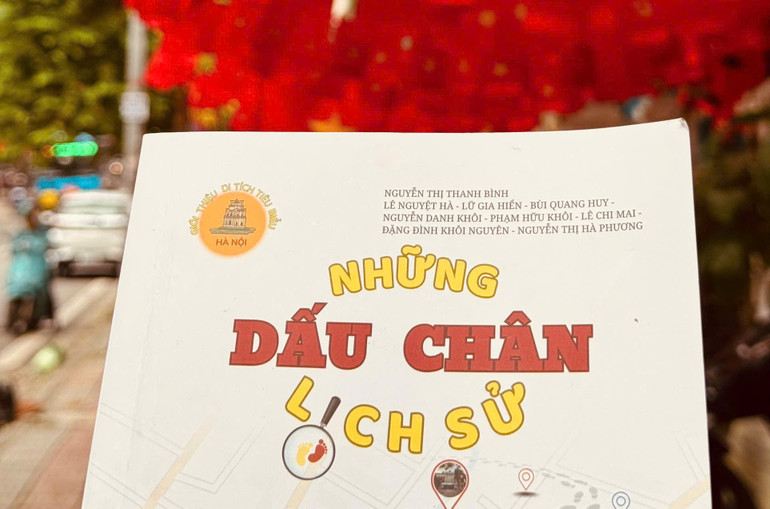
From house number 48 Hang Ngang, where President Ho Chi Minh wrote the Declaration of Independence to Dong Xuan market, the fierce battlefield of 60 days and nights defending the capital; from Lang fortress with the opening shot of the National Resistance War to Huu Tiep lake where B52 remains or Kham Thien Memorial, the 1945 famine memorial site… each location is a historical “footprint” in the heart of the city.
The stories are systematized in the book "History Footprints" , written by a group of eight students aged 13-14 in Hanoi and published by The Gioi Publishing House.

The authors of “History Footprints” include: Khoi Nguyen, Danh Khoi, Huu Khoi, Ha Phuong, Chi Mai, Nguyet Ha, Quang Huy, Gia Hien. They are currently students at Ai Mo Secondary School and Le Ngoc Han Secondary School (Hanoi).
To complete the book, in addition to synthesizing documents from sources such as National Archives Center III, Vietnam News Agency, National Political Publishing House, Vietnam Historical Science Association... the students also directly visited and recorded at historical sites and relics, recording stories with a clear and profound perspective.
Quang Huy shared: “The memory that I remember most is when I visited the house at 48 Hang Ngang, where Uncle Ho wrote the Declaration of Independence. Standing in front of the small room, I imagined the historic moment 80 years ago and felt my heart filled with pride.”

The work gathers more than 100 revolutionary relics and scenic spots, arranged according to geographical space and historical period, especially focusing on the two periods of the National Resistance War in 1946 and "Hanoi - 12 Days and Nights" in 1972.
For Chi Mai, the book also has the meaning of discovering little-known “red addresses”: “I want to include in the book relics that are not only famous but also new to many young people. Hanoi still has many small but meaningful stories, contributing to the appearance of the capital today.”
To complete the work, the group of students spent 10 weeks of the summer researching, taking notes, and compiling.

Not only do students learn more historical knowledge, they also practice teamwork skills, discipline and responsibility. The creative presentation with historical maps and visual symbols also makes the book a “living map” of Hanoi.
The book consists of 100 color printed pages measuring 14.5 x 20.5cm, presenting revolutionary relics and typical scenic spots of Hanoi according to geographical space from the city center to the east-west and south-north areas.
The massive amount of work once made the project seem like it had to stop, but with determination and support from teachers and families, the students were able to launch the book in time for the 80th anniversary of the August Revolution and National Day, September 2.
This is not only the result of learning and experience of Hanoi youth, but also a tribute to the capital, the city of "a time of bombs and bullets, a time of peace", and at the same time contributes to a tour of Hanoi through the lens of history.
Source: https://nhandan.vn/nhung-dau-chan-lich-su-hanh-trinh-ha-noi-trong-mat-hoc-tro-post906498.html






![[Photo] Giant pipeline leading water to West Lake, contributing to reviving To Lich River](https://vphoto.vietnam.vn/thumb/1200x675/vietnam/resource/IMAGE/2025/9/10/887e1aab2cc643a0b2ef2ffac7cb00b4)
![[Photo] President Luong Cuong hosts state reception for Governor-General of Australia](https://vphoto.vietnam.vn/thumb/1200x675/vietnam/resource/IMAGE/2025/9/10/a00546a3d7364bbc81ee51aae9ef8383)
![[Photo] Prime Minister Pham Minh Chinh chairs the 20th meeting of the Steering Committee for important national projects and works](https://vphoto.vietnam.vn/thumb/1200x675/vietnam/resource/IMAGE/2025/9/10/e82d71fd36eb4bcd8529c8828d64f17c)

















![[Photo] Prime Minister Pham Minh Chinh chairs the 20th meeting of the Steering Committee for important national projects and works](https://vphoto.vietnam.vn/thumb/402x226/vietnam/resource/IMAGE/2025/9/10/e82d71fd36eb4bcd8529c8828d64f17c)
![[Photo] President Luong Cuong hosts state reception for Governor-General of Australia](https://vphoto.vietnam.vn/thumb/402x226/vietnam/resource/IMAGE/2025/9/10/a00546a3d7364bbc81ee51aae9ef8383)


![[Photo] Giant pipeline leading water to West Lake, contributing to reviving To Lich River](https://vphoto.vietnam.vn/thumb/402x226/vietnam/resource/IMAGE/2025/9/10/887e1aab2cc643a0b2ef2ffac7cb00b4)
































































Comment (0)